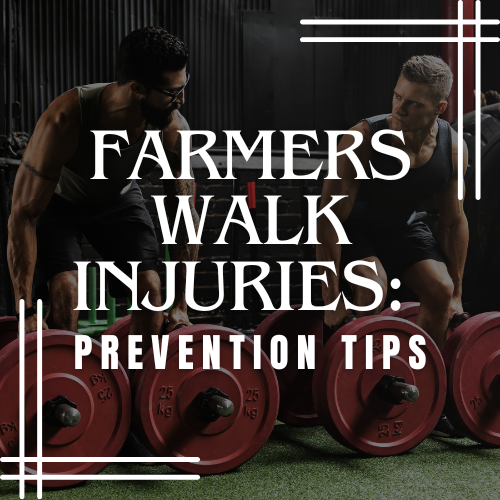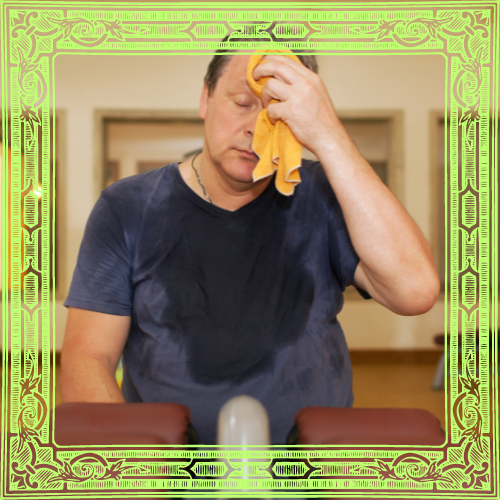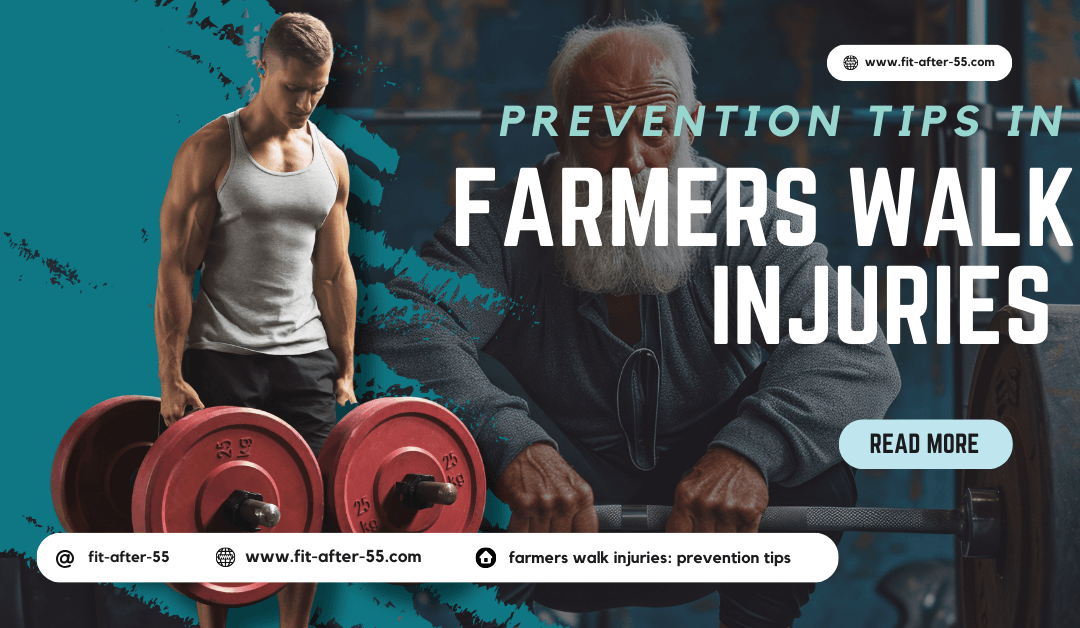Farmers walk is a classic strength-training exercise that involves carrying weights in each hand and walking for a set distance or time. It targets every muscle group in your body, making it an efficient workout to build overall strength. However, like any other form of exercise, farmers walk can lead to injuries if not performed with the correct technique and precautions.

This blog discusses what you need to know about farmer’s walk exercise- from its importance in strength training to potential injuries and prevention tips. We also included key takeaways for preventing injuries like warm-up and cool-down importance, appropriate weight selection, proper form and technique, the role of rest and recovery, and how to handle injuries if they occur. Read on to learn how to safely perform a farmer’s walk without injury.
Understanding Farmers Walk Exercise
The farmer’s walk exercise is a foundational component of resistance training, specifically designed to enhance grip strength and muscle endurance. This exercise effectively targets the upper body, lower body, and core muscles by walking with weights, promoting overall musculature conditioning.
The heavy weights utilized in farmer’s walks challenge grip strength and muscular endurance, making it a functional exercise that significantly improves muscle soreness, strength, and conditioning. Integrating farmer’s walks into a workout regimen can yield substantial benefits in muscle power, conditioning, and reduction of soreness.
Importance of Farmers Walk in Strength Training

Farmer’s walk plays a crucial role in strength training by significantly improving grip strength and muscle power. This exercise not only enhances lower body power and upper body strength but also contributes to better vertical jump height and improved body composition.
Additionally, farmer’s walks are effective for inducing muscle damage and developing lower body power. The exercise protocol for farmer’s walks leads to noticeable differences in muscle soreness, making it an essential component of strength training routines.
Correct Technique for Performing Farmers Walk
To perform farmer’s walks correctly, ensure proper posture with engaged lats and a tight core. Start with lighter weights and gradually progress to heavier ones. Walk upright with purposeful strides, avoiding excessive leaning or swaying. Use a neutral grip for minimal muscle damage.
This technique enhances muscle endurance and grip strength, leading to improved overall conditioning and power. The exercise prescription focuses on controlled movements and gradual weight progression for maximum effectiveness.
Potential Injuries from Farmers Walk Exercise
Performing the farmer’s walk may result in muscle damage, inflammation, or creatine kinase elevation. Common muscle strains may occur due to improper posture, grip strength, or muscle soreness.
Additionally, the exercise can cause lower body soreness and muscle damage if not executed correctly. It may also lead to deadlift-related soreness, conditioning issues, and muscle soreness.
Improper technique can potentially lead to lower body power, muscle soreness, and further muscle damage.

Common Muscle Strains
Muscle strains from farmer’s walk exercises can impact the lower body, upper body, or grip strength. Overuse of the muscles involved in these walks may result in muscle soreness and inflammation.
Improper exercise protocol can lead to muscle damage and soreness. Engaging the body’s musculature properly is crucial in reducing the risk of muscle strains. Farmer’s walks can cause muscle soreness, affecting the lower body.
Joint Pains
Excessive load or improper grip strength can lead to discomfort and soreness in the joints. Incorrect exercise prescription may also contribute to joint pains and lower body soreness.
Farmer’s walk, if performed incorrectly, could result in discomfort and soreness. However, proper exercise protocol and body mechanics can help prevent these issues and promote overall joint health.
Back and Posture Problems
The farmer’s walk exercise demands a focus on proper posture and muscle maintenance to prevent soreness and damage. Incorrect posture during the exercise can lead to lower body soreness, inflammation, and compromised muscle strength.
Ensuring the correct body mechanics prevents muscle soreness and maintains grip strength. Back and posture problems can be mitigated by prescribing the exercise appropriately and managing muscle soreness effectively.

Key Takeaways for Preventing Injuries
-
- Warm-up and cool-down are crucial for preventing muscle soreness, inflammation, and soreness.
-
- Proper weight selection is essential to avoid muscle soreness and improve muscle power.
-
- The farmer’s walk requires correct exercise prescription, body mechanics, and muscle soreness management.
-
- Emphasize muscle soreness, resistance training, and muscle power development to prevent injuries.
-
- Adhering to proper exercise protocol, muscle soreness, and muscle power is key to injury prevention.
Warm-up and Cool-down Importance
Before starting your farmer’s walk exercise, engaging in a thorough warm-up routine is essential. This will contribute to managing muscle soreness, enhancing muscle power, and improving resistance training.
Additionally, incorporating a cool-down routine after completing farmer’s walks can effectively aid in the management of muscle soreness and prevent muscle damage.
Both the warm-up and cool-down phases play a pivotal role in ensuring optimal muscle soreness, muscle power, and resistance training, making them integral components of your exercise prescription for farmer’s walks.

Appropriate Weight Selection

When choosing weights, prioritize grip strength, muscle power, and soreness while maintaining proper form. Weight selection significantly impacts muscle soreness, power, and resistance effectiveness.
In your initial session, choose a weight that seems comfortable. It’s best to begin low and increase as you adjust. Remember that the repetition over the first couple of weeks often causes significant differences in the way the weight feels as you carry.
Gradually progress to heavier weights to enhance muscle soreness, power, and resistance training. Optimal weight ensures muscle soreness and power are maximized. Focusing on proper weight selection is essential for muscle soreness, power, and resistance training efficacy.
Proper form and Technique for Injury Prevention
Blending farmers walk and deadlift exercises can enhance grip strength and muscle activation, while integrating strongman exercises improves postural strength and functional fitness. Incorporating both exercises into training routines ensures comprehensive muscle engagement and alternating between them explores the benefits of each. This approach helps understand the impact of blending farmers walk and deadlift exercises for overall muscle development, making it an optimal strategy for achieving the best results in strength and physiology.
Foot Positioning

Proper positioning of the feet is essential to avoid excessive strain on the lower body during the farmer’s walk. Correct placement contributes to maintaining stability and affects the exercise’s effectiveness while reducing the risk of injury.
By ensuring adequate foot positioning, the weight distribution is even, minimizing the potential for lower body soreness and discomfort. This aligns with optimizing muscle power, grip strength, and overall resistance training without compromising form.
Body Posture
Maintaining a neutral body posture during the farmer’s walk prevents muscle damage and reduces lower body soreness post-exercise. Focusing on correct body posture minimizes the risk of muscle inflammation and supports lower body grip strength.
Appropriate body posture also plays a key role in preventing lower body muscle soreness and ensuring overall stability during the exercise. Implementing the right technique with a focus on body posture is essential for minimizing the risk of injuries associated with the farmer’s walk.
Weight Distribution
Balanced weight distribution plays a pivotal role in preventing muscle soreness and minimizing the risk of lower body damage during the farmer’s walk exercise. It enhances lower body power, reduces muscle fatigue, and contributes to overall strength and endurance.
Proper distribution of weight across the body during the exercise is essential for maintaining optimal performance and preventing undue strain on specific muscles. Achieving even weight distribution ensures that the load is uniformly distributed, promoting lower body stability and reducing the likelihood of discomfort or injury.
Role of Rest and Recovery
Understanding the concept of overtraining is crucial for effective rest and recovery. Adequate rest between farmer’s walk sessions is essential for muscle recovery, significantly preventing injuries.
Proper rest and recovery strategies also help minimize the risk of muscle soreness, making them essential components of an effective farmer’s walk training program.
Understanding Overtraining
Recognizing signs of overtraining is essential for injury prevention during the farmer’s walk. Muscle damage can result from overtraining, emphasizing the need for adequate rest. Understanding overtraining repercussions is vital for effective injury prevention and preventing hindrances in the farmer’s walk progress.
Overtraining can lead to muscle soreness and hinder overall progress. Awareness of overtraining symptoms is crucial in preventing farmer’s walk injuries.
Importance of Adequate Rest Between Sessions
Adequate rest between farmer’s walk sessions is crucial for supporting muscle recovery. Proper rest intervals play a pivotal role in preventing farmer’s walk-related injuries, allowing the body to recover and minimizing the risk of injury.
Emphasizing the importance of the right rest periods between sessions is essential for effectively supporting muscle tissue repair and overall injury prevention.
How to Handle Injuries If They Occur?
Understanding when to seek medical attention is crucial for managing injuries that occur during farmer’s walk exercises. Promptly addressing these injuries can aid in effective recovery and mitigate their impact.
It is essential to have an understanding of appropriate medical interventions when handling farmer’s walk injuries. This helps you understand when healthcare is needed.
When is the Right Time to Seek Medical Attention?
Recognizing the signs of severe injuries is crucial for prompt medical intervention. Knowing when to seek medical attention can prevent complications and ensure optimal recovery.
Understanding the indicators for seeking medical help is vital in managing farmer’s walk injuries. Identifying the appropriate time to seek medical attention is essential for effective treatment.
FAQs
What is the proper form for performing a farmer's walk to prevent injuries?
Proper form is crucial for preventing injuries during a farmer’s walk. Maintain a straight back and engage your core throughout the exercise. Hold the weights with a neutral grip, palms facing inwards. Take small, quick steps while keeping your shoulders down and relaxed. Avoid twisting or bending your body while carrying the weights.
What are some common injuries associated with farmers walk exercise?
Common injuries associated with farmer’s walks include lower back strain and muscle soreness. Improper form or overuse can lead to shoulder and knee injuries as well. Prevent injuries by warming up, stretching, gradually increasing weight, and strengthening core and lower back muscles.
How can I prepare my body to prevent injuries during a farmer's walk?
To minimize the risk of injuries during a farmer’s walk, incorporate exercises targeting the muscles involved, like grip strength and core stability. Gradually increase the weight to avoid sudden strain. Maintain good form and posture, and consider using supportive gear like wrist wraps or weightlifting belts.
Are there any modifications or variations of the farmer's walk that can reduce the risk of injury?
Modifications and variations can reduce the risk of injury in the farmer’s walk exercise. Lighter weights or shorter distances can help, as well as carrying weights on the side of your body instead of in front.
Proper form, such as keeping your shoulders back and down, is also crucial. Gradually increasing weight and distance over time can build strength and minimize the risk of injury.
Ready to try the farmer’s walk exercise?
It is important to prioritize safety and technique to prevent injuries while performing the Farmers Walk exercise. This includes using the correct form, maintaining proper posture, and distributing the weight evenly.
Additionally, warming up and cooling down is crucial for injury prevention, as is selecting an appropriate weight for your fitness level. Rest and recovery play a significant role in avoiding overtraining and allowing your body to heal and rebuild.
However, if an injury does occur, it is important to know when to seek medical attention. Listening to your body and promptly addressing any discomfort or pain can help prevent further damage. Remember, your health and well-being should always come first.

